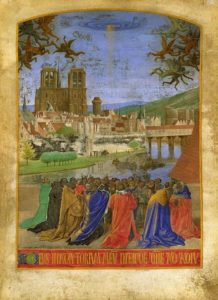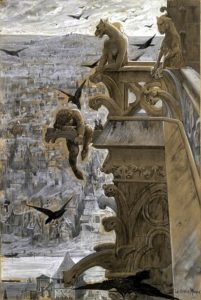Our Lady in peril
by Agnès Poirier
“The frantic efforts to save a building so dear to the French are vividly brought to life.” The Times
Of the night of the fire I remember a kaleidoscope of images, a collision of emotions, in quick succession. Through my kitchen window seeing bright-yellow plumes of smoke coiling into the sky, then rushing down the stairs onto quai de la Tournelle, standing right opposite Notre-Dame’s south rose window, the red and orange tongues of fire leaping from the roof, the resounding silence of the crowd, the stunned look in people’s eyes, the horrific beauty of the moment, tears pearling down cheeks, lips forming silent prayers, the precise, focused actions of firefighters as if suddenly transformed into field surgeons, water hoses appearing at every corner like giant serpents, the flaming torch of the spire about to collapse, the pink-hued medieval stones against a royal-blue sky, then the black smoke rising from the north tower, and the unbearable realisation and excruciating thought: Our Lady might go.
We need certainties: they are the framework of our existence, the signposts without which we can’t navigate life, let alone endure its many tests and trials; for 850 years Notre-Dame was one such. Those of us who had forgotten received a shocking reminder on the night of 15 April 2019. If Notre-Dame could crumble in front of our eyes and disappear from our lives, so too can those other certainties – democracy, peace and fraternity. The head teachers of Paris, who summoned psychologists to assist in primary schools the morning after, understood this perfectly. Many children brought with them little plastic bags filled with fragments of blackened timber that they had picked up from balconies and pavements. Their parents had told them that those tiny bits of charcoal dated back to the Crusades, and they now needed to be comforted that nothing irreparable had taken place. Reassuring the children was easier than reassuring ourselves.
That evening, as the first images of the tragedy started flooding onto social networks and TV screens, a wave of emotion almost immediately surged towards the tiny island of Île de la Cité in Paris, the cradle of France, from every corner of the world. We Parisians felt, as often in history, at one with the world, united in a harmony of grief.
Why were we all feeling so traumatised?
Notre-Dame is one of mankind’s greatest architectural achievements, the face of civilisation and the soul of a nation. Both sacred and secular, gothic and revolutionary, medieval and romantic.”
Notre-Dame has always been far more than a cathedral, a place of worship for Catholics and a beautiful monument whose stained glass dates back to the thirteenth century. Notre-Dame is one of mankind’s greatest architectural achievements, the face of civilisation and the soul of a nation. Both sacred and secular, gothic and revolutionary, medieval and romantic, she has always offered a place of communion and refuge to everyone, whether believers and atheists, Christians or otherwise.

The Right Hand of God Protecting the Faithful against the Demons by Jean Fouquet, c. 1452–60. Robert Lehman Collection / Wikimedia Commons
Victor Hugo and his hunchback transformed Notre-Dame into a world heroine and saved her from the dire neglect into which she had fallen two hundred years ago. She rose again in the 1860s, in neo-medieval magnificence, thanks to the architect Eugène Viollet-le-Duc, a scholar of medieval art who reinvented Notre-Dame and gave her a spire with which she could have been born. Through the new art forms of photography and cinema she became a universal icon, a character of flesh and blood in the world’s imagination, alongside Quasimodo, Esmeralda and the monstrous but endearing gargoyles adorning her facade. In this way a love of Notre-Dame, this living being of a gothic cathedral, has passed from one generation to the next.
Her mesmerising beauty also made the possibility of her demise all the more inconceivable. Built and rebuilt over ten centuries, a constant work of perfection in progress, Notre-Dame’s loveliness is both unique and multifaceted. Everyone has their favourite view of the cathedral. For some it is the view from the pont de l’Archevêché, as one walks from the Left Bank towards the garden lying in the shadows of her flying buttresses, or slightly further away eastwards, from the middle of pont de la Tournelle, where the cathedral rises like the majestic prow of a ship called France. For others it is from quai d’Orléans on Paris’s twin island, Île Saint-Louis, where she suddenly appears at the curve of the leafy embankment, or perhaps simply from the middle of the parvis – the square in front of the main doors of the cathedral, the west rose window and twin towers in all their glory. For others still it is from quai Montebello and the terrace of the Shakespeare & Company bookshop.
Pablo Picasso liked the view from the garden at the back. On 15 May 1945, the bullfighting enthusiast told the photographer Brassaï: “Have you ever photographed Notre-Dame from behind? I quite like Viollet-le-Duc’s spire. It looks like a banderilla sticking out of her back!”
My own favourite is from the corner of rue de la Bûcherie and rue de l’Hôtel Colbert, below the quai de Montebello, at the bottom of three medieval steps, right next to the building where in October 1948 Simone de Beauvoir rented a tiny attic room with a view of the spire. At street level this narrow glimpse of Notre-Dame keeps you guessing and wanting to see more, and infallibly draws you towards her.
Notre-Dame’s beauty is of a kind one never takes for granted; it is a constantly renewed miracle, which stuns you each time you meet her gaze. The secret of her loveliness lies in a powerful combination of familiarity and nobility, both warm and grandiose. How can a monument be so intimate and so imposing at the same time?
To dive into Notre-Dame’s past is to immerse oneself in the soul of France, a history full of glory, torment and contradictions. In the last eight hundred and fifty years, Notre-Dame has witnessed the best of France and the worst of France. On 15 April 2019 she almost died as a result of human carelessness and was only saved in extremis by the courage of those ready to sacrifice their lives for her.
—
Notre-Dame: The Soul of France pays tribute to Maurice de Sully, the peasants’ son who became bishop of Paris and oversaw the initial construction of the cathedral in the late twelfth century; and it features Henry IV, who, realising that he couldn’t govern against Paris, converted to Catholicism, paid his respects to Notre-Dame and reconciled a country deeply divided by thirty years of war between Protestants and Catholics. Louis XIII consecrated his crown and France’s fortune to the Virgin Mary at Notre-Dame, and his son Louis XIV, the Sun King, fulfilled his father’s vow. The marble Pietà by Nicolas Coustou, flanked by statues of both kings kneeling, was left untouched by the fire, the spire and vault having collapsed at their feet.
In 1789 and through Robespierre’s Terror, the shrewd cathedral organist played revolutionary songs and the ‘Marseillaise’ instead of religious hymns, and an equally astute canon decided to safeguard the statues of the Sun King and his father, leaving the Virgin Mary to fend for herself alone before stern atheists and staunch republicans. He did well: they only dared remove her golden crown. The twenty-eight kings of the facade’s upper gallery were less lucky: each of them lost his head. Napoleon restored Notre-Dame, which had been rededicated as a temple of reason during the revolution, to her original faith. By choosing to be crowned emperor there in 1804 he also placed her at the centre of France’s public and political life, paving the way for Victor Hugo and his hunchback.
Hugo’s novel, written during the tumultuous days of the July revolution of 1830, perfectly encapsulated the communion between the rebellious people of Paris, the cathedral’s deformed bell-ringer Quasimodo and the beautiful bohemian Esmeralda, under the watchful gaze of Archdeacon Frollo. The success of the novel, published with richly evocative illustrations, was such that a whole country suddenly reappraised its medieval heritage and felt the need to attend to its crumbling monuments. Shortly after publication, France’s national service for historic monuments was created and soon a new breed of architects, both artists and scholars, was recruited by the state to resurrect the past grandeur of old stones.
For twenty-two years Viollet-le-Duc painstakingly restored Notre-Dame to neo-medieval splendour. A few years after the spire was finished, Baron Haussmann extensively redesigned Paris and the Île de la Cité. By clearing medieval dwellings and demolishing narrow lanes nearby, Haussmann added majesty to the cathedral. Now standing alone on the tip of the island, she was visible from miles away.
The embers were still warm when French opinion seemed to divide into opposing groups, those wishing to see her as she was again and those wanting to add a touch of twenty-first-century genius.”
On the night of the fire, many Parisians thought of 26 August 1944 when, having just walked down the Champs-Élysées acclaimed by two million of his compatriots, General de Gaulle stopped at Notre-Dame to attend a Te Deum, a special service celebrated with glorious music to give thanks following a time of peril. As he entered the packed cathedral through the central portal, gunshots rang out from the upper gallery. Snipers were shooting at the French leader, but de Gaulle kept walking, head high, into the nave towards the choir. The crowd had thrown themselves flat on the marble floor but, on seeing de Gaulle so calm and seemingly unaffected, they slowly resumed their places on the pews. The Magnificat was kept short and the general left as he came in, walking tall.
What would de Gaulle make of the battle over Notre-Dame’s reconstruction? The embers were still warm when French opinion seemed to divide into opposing groups, those wishing to see her as she was again and those wanting to add a touch of twenty-first-century genius. Will this be a battle between the timid and the daring, or between the wise and the foolish? Even the French prime minister, Édouard Philippe, couldn’t help launching an international design competition for the rebuilding of the spire only two days after the fire. President Macron himself talked of rebuilding the cathedral as ‘even more beautiful than before’ in just five years. Their words unleashed the most extravagant wave of ideas on social networks: among them, a crystal spire, a roof garden, a gigantic golden torch, a swimming-pool roof and a glass dome. Architects, desperately looking for publicity, embraced the international competition and promoted their fantastic plans for Notre-Dame. Pandora’s box was open.
What is this French urge to be radical, to redesign, to reform and dazzle the world? Do we really think our twenty-first-century genius can match that of Notre-Dame’s medieval builders? Why not simply, for once, preserve and restore Notre-Dame to the state in which Viollet-le-Duc left her in 1865? There will still be an opportunity to redesign her surroundings and access for her fourteen million visitors a year, which were, at best, shambolic. There may even be a chance to create a long-desired and much-needed museum across the parvis, at the Hôtel-Dieu, a medieval hospital which is today partially empty.
The battle for the reconstruction of Notre-Dame has just begun and promises to be fierce. The three richest families of France – the Pinaults, Arnaults and Bettencourts, who pledged 500 million euros for Notre-Dame’s rebuilding as the fire was ravishing the roof, have had to justify their actions. Weren’t they actually more interested in the tax breaks usually attached to such donations than in the fate of the cathedral? asked the Gilets Jaunes (Yellow Vests). Couldn’t they spend this kind of amount of money on people in need rather than old stones? Weren’t there worthier causes than a great pile of charred debris?
Writing Notre-Dame: The Soul of France has been a singular journey, from a state of desolation to one of quiet optimism. Since 16 April 2019 when, as dawn broke in pink hues over the Seine, I saw Notre-Dame reappear, still standing, hurt yet magnificent, I have remained timidly hopeful. A few hours earlier, binoculars in hand, I had punched the air when I realised that her stained-glass windows had survived.
Meeting the men and women who saved Notre-Dame; talking to those who have tended to her like the most attentive nurses through the following weeks and months, 24/7, strengthening her structure, painstakingly collecting and storing every charred or broken remnant that can be reused; interviewing those who will advise on her reconstruction and those who will finance it; visiting the building site, touching the stone, as strange as it sounds; even taking a blood test for lead poisoning – all this has made me acutely aware of the challenges that lie ahead and of the boundless and unconditional goodwill and commitment there is to see her rise again.
From the prologue to Notre-Dame: The Soul of France (Oneworld, £16.99)
 Agnès Poirier is a writer, commentator and broadcaster based in Paris. She is a regular contributor on politics and arts for the BBC, CNN, Sky News, Channel 4 and France 24, and writes for the Guardian, Observer, The Times, Evening Standard and The New York Times, among others. She is the author of the acclaimed Left Bank: Art, Passion and the Rebirth of Paris, 1940-50 (Bloomsbury/Henry Holt, 2018). Notre-Dame: The Soul of France is published in hardback by Oneworld.
Agnès Poirier is a writer, commentator and broadcaster based in Paris. She is a regular contributor on politics and arts for the BBC, CNN, Sky News, Channel 4 and France 24, and writes for the Guardian, Observer, The Times, Evening Standard and The New York Times, among others. She is the author of the acclaimed Left Bank: Art, Passion and the Rebirth of Paris, 1940-50 (Bloomsbury/Henry Holt, 2018). Notre-Dame: The Soul of France is published in hardback by Oneworld.
Read more
agnespoirier.org
@AgnesCPoirier
Author portrait © Hannah Starkey



